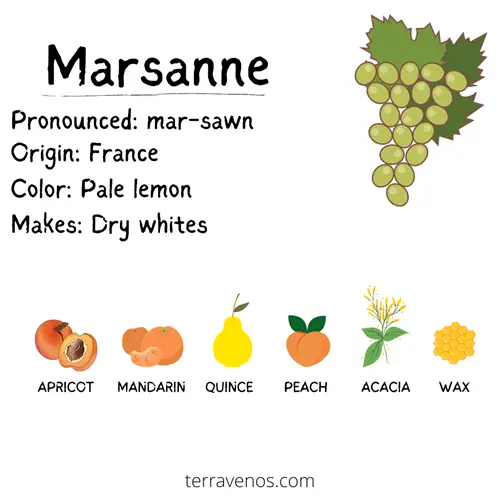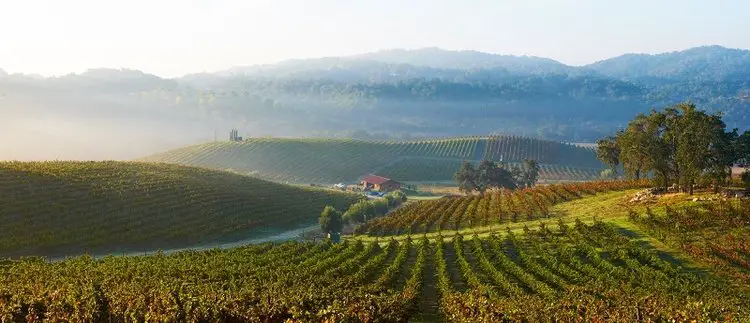
Pronunciation: mahr-SAWN
Marsanne is a white wine grape with origins traced back to the Rhône Valley in France. Primarily used in blends, Marsanne also stands alone as a single varietal wine, showcasing a unique profile characterized by floral notes, stone fruits, and a touch of almonds.
- What Kind of Wine Is Marsanne?
- Where Does Marsanne Wine Come From?
- What Does Marsanne Smell Like?
- What Does Marsanne Taste Like?
- Is Marsanne a Heavy Wine?
- How to Serve Marsanne Wine
- What Is Marsanne Similar To?
- What Is the Difference Between Marsanne and Viognier Wines?
- Marsanne Synonyms
- Marsanne Food Pairing Suggestions
- Marsanne vs. Other Varietals
- Notable Marsanne Producers and Bottles to Try
- Final Thoughts – Marsanne as a Must-Try White Wine Varietal
- Thirsty for More?
What Kind of Wine Is Marsanne?
Marsanne is a medium to full-bodied white wine with a balanced acidity, presenting a harmonious combination of floral aromas, stone fruit flavors, and subtle almond undertones. It falls between the richness of Chardonnay and the crispness of Sauvignon Blanc, offering a delightful alternative for white wine enthusiasts.
Where Does Marsanne Wine Come From?
Originating from the Rhône Valley in France, Marsanne has deep roots in the winemaking traditions of the region. It plays a significant role in both northern and southern Rhône, contributing to renowned blends such as Hermitage and Saint-Joseph in the north, and Châteauneuf-du-Pape in the south.
Marsanne in the Northern Rhône
In the northern Rhône, Marsanne is often blended with Roussanne to create complex and age-worthy wines. The appellations of Hermitage and Saint-Joseph showcase the grape’s ability to produce full-bodied, textured whites with aging potential.
Marsanne in the Southern Rhône
In the southern Rhône, Marsanne contributes to the blend of Châteauneuf-du-Pape, adding richness and depth to the white wines produced in this iconic appellation.
Helpful Wine Buying Tip: Look for the term “Hermitage Blanc” or “Saint-Joseph Blanc” on the label for a Marsanne-dominant wine from the northern Rhône.
Other Notable Marsanne Growing Regions
Beyond France, Marsanne has gained recognition in various wine regions worldwide. In regions like California, Australia, and South Africa, winemakers embrace Marsanne for its ability to produce full-bodied white wines.
What Does Marsanne Smell Like?
Marsanne is distinguished by its aromatic profile, featuring floral notes, particularly honeysuckle and acacia, along with the subtle fragrance of white blossoms. It may also exhibit hints of ripe peaches, apricots, and a touch of almonds, providing a sensory journey with every swirl of the glass.
Fun Wine Fact: Marsanne is often blended with Roussanne and Viognier to create the iconic white blend known as the “Rhône White Trinity.
What Does Marsanne Taste Like?
Marsanne’s flavor profile is a delightful interplay of stone fruit flavors, including ripe peaches and apricots, complemented by a subtle nuttiness from the almonds. The wine’s moderate acidity contributes to a refreshing finish, making it a great pairing partner for rich meals.
Helpful Personal Tip: Try pairing Marsanne with different cheeses, from mild brie to nutty Gruyère.
Is Marsanne a Heavy Wine?
Marsanne is a heavier wine, and typically falls into the medium to full-bodied category, offering a substantial weight on the palate. However, the wine’s versatility allows for variations in style, with some Marsanne wines leaning towards a more refreshing, medium-bodied profile.
How to Serve Marsanne Wine

Serve Marsanne chilled but not too cold, around 45-50°F (7-10°C). This temperature range allows the wine to express its full aromatic potential while maintaining a refreshing quality.
Glassware
Opt for a medium-sized, standard white wine glass with a slightly tapered rim to concentrate the delicate aromas. This style of glass enhances the overall tasting experience by directing the wine’s bouquet toward your nose.
Decanting
Most Marsanne wines don’t need decanting. You may find that you have a well-structured Marsanne wine that will benefit from a brief decant to help the wine open up. Alternatively, give the glass a stiff swirl before sipping.
Aging Potential
You will want to drink most lighter Marsanne wines when you purchase it. Fuller-bodied Marsanne wines may be able to age. If you plan on cellaring your Marsanne wines, then consult with a bottle shop expert before buying.
What Is Marsanne Similar To?
Marsanne is similar to Chardonnay. Like warmer climate Chardonnay, Marsanne has a fuller body and medium-low acid. Marsanne and Chardonnay share peach and apricot notes.
What Is the Difference Between Marsanne and Viognier Wines?
Marsanne tends to offer more pronounced stone fruit flavors and a subtle nuttiness, while Viognier brings intense floral aromas, particularly of jasmine and orange blossom, along with ripe peach and apricot notes.
Marsanne Synonyms
Marsanne goes by various names in different regions, including Ermitage, Ermitage Blanc, Grosse Roussette, and Avilleran.
Marsanne Food Pairing Suggestions

Marsanne’s versatility makes it an excellent companion for a range of dishes. Its floral and stone fruit notes pair particularly well with lighter dishes that have herbs and subtle earth flavors.
Quick Tips: Marsanne Food Pairing
- Grilled chicken with lemon and herbs
- Seared scallops with a citrus glaze
- Creamy risotto with asparagus and Parmesan
Marsanne vs. Other Varietals
Compared to Chardonnay and Sauvignon Blanc, Marsanne will be more floral with quince and stone fruit characteristics. Cool climate Chardonnay tends to be more acidity, and oaked Chardonnay will have buttery toasty notes. Sauvignon Blanc leans towards zesty citrus notes.
Notable Marsanne Producers and Bottles to Try

Exploring Marsanne-rich wines from dedicated producers will take a special trip to the wine store. Marsanne isn’t a typical wine that you’ll find in your grocery store. Ask for help from the shop keeper if you’re looking for Marsanne wines.
Helpful Wine Buying Tip: If you’re looking for a classic French Marsanne wine, it’ll be in the French section under Rhone Valley.
Keep an eye out for wineries known for their commitment to crafting exceptional Marsanne wines, such as:
- Chapoutier (Northern Rhône, France)
- Tahbilk (Victoria, Australia)
- Tablas Creek Vineyard (California, USA)
Final Thoughts – Marsanne as a Must-Try White Wine Varietal
With its floral aromas, stone fruit flavors, and full-bodied profile, Marsanne stands as a must-try white wine. Here are three key takeaways to remember:
- Distinctive Flavor Profile: Marsanne offers a unique combination of floral aromas, stone fruit flavors, and subtle almond notes.
- Versatility: Marsanne’s versatility allows it to pair well with a variety of dishes, from seafood to creamy risottos.
- Chardonnay Alternative: If you love full-bodied Chardonnay wines, then you’ll enjoy Marsanne.
Thirsty for More?
Just getting started with wine? Head over to this post that explores key wine regions and their signature wines.
Hosting DIY wine tastings is the best way to learn about wine. Here’s how to host your own tasting party.



